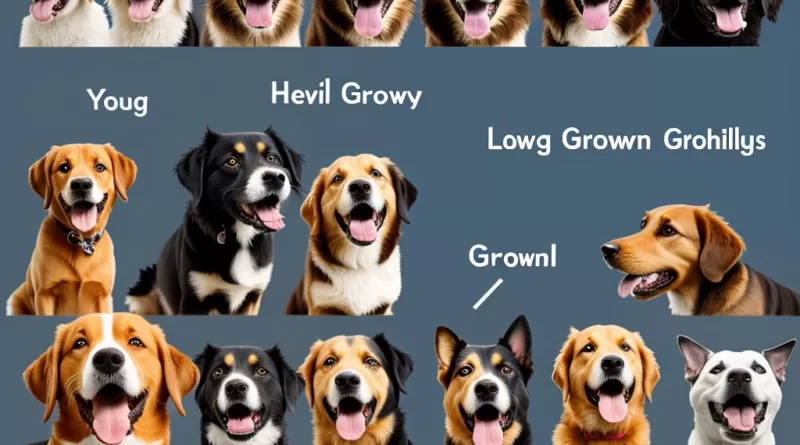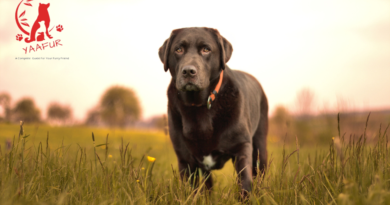Understanding Dog’s Mixed Signals: Growling and Tail Wagging Explained
As sentient beings, dogs have propagated a complex system of communication, expressed chiefly through body language and vocalizations. Among these, growling and tail wagging offer key insights into a dog’s feelings and intentions. While seemingly counterintuitive, instances when dogs growl at puppies yet wag their tails are not entirely infrequent. Understanding such behaviors requires decoding the intricate language of dogs, grasping the nuances of canine body language, and recognizing the potential for mixed signals. The goal of this exploration is to offer a comprehensive study of these actions, shedding light on their context and connotations, and to provide guidance for observers in navigating their responses.
The Language of Dogs: Growling
Understanding Canine Communication: Growling and Wagging Tail
Dogs communicate their emotional state and intentions to others around them through an intricate language of vocalizations and body language. These vocalizations, such as growling, can have different meanings in different contexts. Likewise, movements like tail wagging can carry a range of messages.
Contextual Interpretation of Growling at a Puppy
The context of the growl greatly influences its interpretation. If the older dog and the puppy are engaged in play, the growling accompanied by a wagging tail can be an expression of playful excitement and enthusiasm. Dogs often ‘play growl’ while engaging in mock fights, energetic chasing or play-biting, which can sound intimidating to human ears, but are a normal part of dog communication.
If the situation involves a puppy invading an older dog’s personal space or taking away something of value (called resource guarding), the growl might serve as a warning to the puppy to back off. In such situations, the wagging tail may demonstrate that the older dog is not seeking a fight but is merely establishing and defending its boundaries.
Teaching Puppies the Rules of Engagement
In the canine world, older dogs often take on the role of mentors to younger dogs, teaching them about appropriate social behavior, self-control, and manners. When an older dog growls at a puppy while wagging its tail, it might be trying to teach the younger pup a lesson about acceptable behaviors, much like humans discipline children when they act out.
The wagging tail comes in here as a sign of animation or arousal, rather than a specifically friendly gesture as humans commonly misinterpret. It can be viewed as a signal that mitigates the potential aggressive message of the growl, indicating the older dog’s intention to provide a lesson rather than initiate a fight.
How to Respond When a Dog Growls at a Puppy
Although an older dog’s growling at a puppy while wagging its tail often denotes social instruction rather than aggressive intent, it is essential to observe these interactions closely. If the growling escalates or it appears that the puppy isn’t ‘getting the message,’ it may be necessary for owners to intervene to prevent potential misunderstandings and harm.
To ensure safety and health in interactions between older dogs and puppies as well as any two dogs, it’s of utmost importance to recognize and understand the subtleties and environments in which canine communication occurs.

Canine Body Language: Tail Wagging
Deciphering Tail Wagging
One common form of communication among dogs is tail wagging, which could suggest a range of emotions such as fear, excitement, or even aggression. Many assume that tail wagging is always a sign of friendliness or joy, but that’s not necessarily true. The meaning behind a dog’s wagging tail can be significantly influenced by the speed, direction, and position of the wag.
Tail Position: Direction and Speed
The position of the tail can provide many insights into a dog’s emotional state. When a dog wags its tail high and stiff, it can indicate aggression or dominance. If the tail is lowered and tucked between the legs, it can mean the dog is fearful or submissive.
The speed of the tail wagging also matters. Quick, rapid wags can suggest an excited or agitated state, while slower wagging generally means contentment or calm. The direction also matters. Research suggests dogs wag more to the right when they feel positive and to the left in response to negative emotions.
Decoding Mixed Signals: Growling and Tail Wagging
When a dog growls at a puppy while wagging its tail, it can produce conflicting signals that might be confusing. The growling suggests an aggressive stance or a warning, while the wagging tail may suggest friendliness or excitement.
However, this may not exactly signify aggression or playfulness separately. Growling can sometimes be a part of play, and an overly excited or agitated dog may wag its tail. This behavior might be common in older dogs trying to teach younger dogs about boundaries or social rules.
Understanding the Interaction Between Adult Dogs and Puppies
When an adult dog growls at a puppy, it might be a technique for teaching the puppy about social etiquette within the canine world. Dogs, like humans, use language and behaviors to establish boundaries and communicate. Wagging tails during these lessons could mean the adult dog is not in full aggressive mode, but rather in a state of heightened alertness or frustration.
It’s crucial to observe the individual signs and the whole context when a dog growls at a puppy and simultaneously wags its tail. Other body language cues will also give you the true meaning behind their actions. For example, erect ears and direct eye contact usually signify a challenge, while relaxed ears and averting eyes might mean submission.
Interpreting Dog Behavior Correctly
It’s important to not interrupt these interactions too quickly, as puppies need to learn these important lessons about dog behavior. Growling by the adult dog can be a correct and proper way to discipline a puppy who is being too hyperactive or not respecting boundaries.
Yet, it’s essential to always supervise interactions between adult dogs and puppies to ensure they don’t escalate into actual aggression.
The language of dogs is undeniably complex, making the interpretation of their behavior contingent on understanding the nuance and context of different signs. A wagging tail, a primary form of communication, is not always a reliable indicator of a dog’s friendliness or enthusiasm. Instead, the dog’s full body language, their facial reactions, and their vocalizations all contribute to the intricate language of canines.

See also: Does Pine Sol Get Rid of Cat Urine Smell?
The Significance of Mixed Signals in Dogs
Decoding Mixed Signals from Dogs: A Deeper Dive Into Canine Body Language
Getting to the crux of why a dog might growl at a puppy while simultaneously wagging its tail necessitates a broader understanding of canine communication. Dogs, like humans, reflect their emotions through a range of body language, vocal signals, and facial expressions. Dogs register different emotions using various gestures such as wagging tails, standing ears, baring teeth, and producing sounds like barking, growling, or whining.
These signals, however, often seem contradictory or bewildering to humans. While a wagging tail is typically associated with happiness and playfulness, its significance is far more diverse. It may indicate feelings ranging from joy and excitement to anxiety and fear. Similarly, growling, commonly linked to aggression, can also communicate a dog’s fear, discomfort, or stress in different situations.
A Growling Dog and Wagging Tail: What Does It Mean?
When a dog growls at a puppy but also wags its tail, it could be indicating a mix of emotions or trying to convey different messages simultaneously. This combination of behavior elements can mean the older dog is sending a warning to the puppy, in a non-threatening way. The growl acts as a warning – “I’m not comfortable with you being close to me,” or, “You’re being too playful and it’s too much for me.” The wagging tail, however, signals, “I’m not a threat to you.”
Factors Affecting Mixed Signals in Dogs
A dog’s behavior is influenced by a host of factors, including its mood, the environment, and interactions with other animals or humans. Emotional states such as nervousness or confusion can lead to mixed signals. For example, an older dog that is anxious or unsure about a new puppy may growl as a form of warning, while wagging its tail to show it means no harm.
The dog’s socialization and past experiences can also play a part in their reactions. A dog that has had negative experiences with other dogs or puppies in the past may be quicker to growl as a pre-emptive move to protect itself, even when wagging its tail.
Decoding Your Dog’s Mixed Signals
Grasping the complexity of a dog’s behavior often requires keen attention to details, particularly in the wider interactions they have with other dogs. Monitoring the dog’s entire body language, understanding the situation, and taking into account the dog’s history can render valuable insights into their actions.
If an older dog seems aggressive towards a puppy, displaying growling behavior but wagging its tail, it becomes critical to observe and intervene as necessary, such as creating a safe separation between the two dogs. This intervention serves to show the older dog that the puppy is not a threat and that the situation is manageable. Moreover, consulting a professional dog behaviorist is advised as they will be able to offer guidance tailored to the specific temperament and history of your dogs.

How to Respond to Mixed Signals in Dogs
Deciphering the Puzzling Behavior: Growling and Tail Wagging
For new pet owners, managing a canine behavior like growling at a puppy while wagging its tail can be an enigma. It’s vital to remember that like humans, dogs employ a range of behaviors, actions, and sounds to communicate.
Growling is generally seen as an aggressive or defensive posture in dogs. However, this is not always a sign of antagonism. Dogs can display a growl during play, signifying enjoyment and inviting more fun. Conversely, while tail wagging is considered a dog’s expression of happiness or excitement, it can actually encompass a myriad of emotions such as anxiety, fear, and even aggression. Therefore, viewing growling and tail wagging in conjunction may signal a playful mood, a warning, or both, making it important to assess the entire context of the interaction.
Interpreting Mixed Signals in Dogs
To accurately interpret this mixed signal of growling and tail wagging by a dog towards a puppy, it’s essential to consider the situation’s context. Observe the other social cues and visual signals the dog is giving. Facial expressions, body postures, and the excitement level can give you a clear idea of what’s happening.
Look at other body language, for instance, if the ears are held back or pointing forwards, whether the gaze is direct or averted, how the body is being held – tense or relaxed. Consider the tail’s position and movement as well – an overly wagging tail held high might mean the dog is over-excited or anxious, while a relaxed and naturally wagging tail may signify a comfortable and happy state.
Managing Mixed Signals in Dogs
Correctly managing and responding to these mixed signals can help prevent any potential conflicts and misunderstandings. If a dog growls at a puppy but wags its tail in a relaxed manner and exhibits other signs of friendliness like a relaxed body posture and a soft gaze, it might be playing. Allow them to interact, but supervise closely to ensure play doesn’t escalate into aggression.
However, if the dog displays signs of discomfort or aggression like stiff body posture, bared teeth, or intensely staring, it’s best to intervene and gently separate the animals. The dog might be feeling threatened or overwhelmed and requires a calm and safe environment to cool down.
Preventing Escalation
To prevent any unwanted conflict and maintain a peaceful pet environment, interventions should ideally be proactive rather than reactive. Regular socialization from a young age is key to making dogs more comfortable with other animals and accepting of puppies. Training using positive reinforcement methods and safely introducing new animals or puppies can also help in preventing any risky situations.
In essence, understanding and appropriately responding to your dog’s mixed signals can significantly contribute to maintaining a positive relationship with your pet while ensuring their comfort, security, and happiness.

Deciphering dog behavior is a complex, yet enriching endeavor. Through the lens of understanding, actions like growling while tail wagging lose their apparent contradiction and become part of a meaningful behavioral matrix. Whether these signals reflect nervousness, indecision, or a teaching moment, understanding the context is crucial. With a grounded understanding of these behaviors, observers can ensure the safety of all parties involved and foster a positive rapport with our canine companions. It’s an interesting dance of observation and interpretation that deepens the bond between us and our furry friends, helping us navigate the world using a language beyond words.
Enjoyed this Article? You May Also Like:




